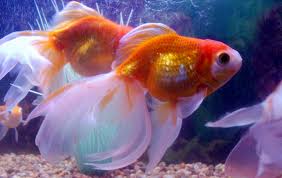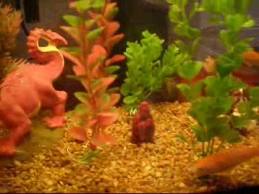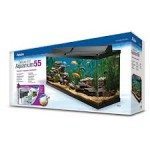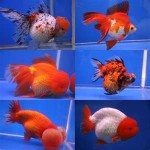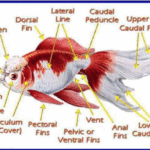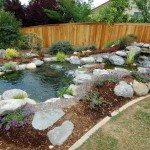Raising the ‘baby fish’ through the larvae and fry stage to maturity can be a challenge for new fish keepers. However successfully breeding of goldfish and rearing of fish is well within the scope of average fish fanciers once the basics of goldfish reproduction and water requirements are understood.
#1 Goldfish breeding facts
- All types of goldfish reach sexual maturity at the age of 1 year if given a proper diet and enough space to thrive. First time breeders should take advantage of reading the descriptions of the ideal specimen of your chosen variety. Each type has specific physical traits which if present exemplify that variety of fish.
- Variety faults, such as split tails in fancy tailed varieties should be avoided. A general rule of thumb is buy the best potential breeding stock available.
- Get the best spawning success rate by keeping more males than females. The usual ratio is 2 males for every female.
- Novice breeders are advised to stick to the less extreme forms of fancy goldfish. All too often the exotic types can’t breed on their own and need to be bred artificially by ‘hand stripping’ the fish of their eggs and milt. The process of hand stripping, while ensuring a breeding can harm valuable breeding fish if done incorrectly.
#2 Sexing your goldfish
When mature, goldfish can be sexed fairly easily. (How to tell if the fish is male or female)
- Mature males develop breeding tubercles on their gill covers (operculum) and along the first ray of the pectoral fins. When spawning gets closer the males will chase the female around the tank.
- Females are identified by their more plump generous bodies that are designed to carry maturing eggs. They’ll release and scatter the eggs during mating. Look for your females with large rear and pectoral areas.
#3 Water temperature for goldfish breeding
In the wild, sexual reproduction takes place after winter water temperatures rise and daylight hours increase.
If you have a tank with a number of fish look for your breeders and introduce these into another prepared tank. This tank should hold at least 20 gallons. For the best mix of breeding fish, try to isolate 3 of your best males and 2 female goldfish.
Leading up to breeding aim to replicate the natural spring diet by introducing some brine shrimp into the tank. As always, be careful to avoid overfeeding as the scraps will fall to the bottom and pollute the water.
The optimum temperature for breeding success is 20º celsius although breeding can occur within a temperature range of 10 to 26º celsius.
In captivity we can artificially replicate the natural seasonal changes by gradually increasing tank temperatures.
How do I safely increase water temperature?
- Gradually raise the temperature by 2ºc (3ºf) a day until it reaches 20ºc.
- Partially change the water each day (up to 20%) to stimulate breeding conditions. Don’t forget the water conditioner.
#4 Preparation for the fry
Tips to give fry the best chance of survival.
Prior to breeding goldfish, you should prepare a nursery tank using aged water from the tank in which spawning will take place.
Gentle filtration and aeration using a sponge filter and air stone ensures water quality throughout incubation and hatching.
This tank should be filled to a depth of 6 inches. Water temperatures in the hatchery tank should be regulated to achieve an optimum hatching temperature of 21 degrees celsius.
#5 Spawning Mops
What is a spawning Mop?
The ‘mops’ are designed to resemble plants in the wild and float giving the fertilized eggs something to adhere to and develop on. A string mop can be made simply using lengths of yarn, secured, with a cork attached.
Why is a string mop used?
Fertilized eggs can adhere to this environment. They enable us to collect and protect the eggs for development.
Why are they important?
1.To secure the fertilized eggs
2.To safeguard the eggs because unsecured eggs tend to be eaten by adult goldfish.
How do I make a spawning mop?
Materials you’ll need
- nylon yarn/wool (dark green is preferred because it resembles plants)
- A4 size board or cardboard
- a cork (ie like that from a wine or champagne bottle). Alternatively a piece of polystyrene will work
1.Sterilize the yarn and cork by boiling to make safe for the fish.
2.Cut a length of yarn the width of your board (horizontal) and secure to the top of the board
3.Wrap or wind the yarn around the stiff cardboard, vertically, 40 to 50 times.
4.Draw together the edges of the piece of yarn that you have placed horizonally on the board and tie securely. This keeps the lengths of yarn together.
5.Cut the yarn along the bottom edge of the board.
6.Fold the yarn in the center (where it’s been secured) and place the cork.
7.Cover the cork with the yarn and tie a piece of yarn at the bottom of the cork tightly around the lengths of yarn to hold the cork firmly in place.
8.Boil water in a large pan, remove from heat. Soak the breeding mop for around 15 mins. This soaking removes residue on the yarn ensuring the spawning mop can safely be introduced to the tank.
#6 Goldfish Breeding Behavior
Tank temperatures are now conducive to breeding goldfish and mating behavior will soon be observed.
Males will begin a “spawning chase”. Females are pursued (they appear to being pushed around the tank) and nudged by the male to release their load of eggs.
Females in top breeding condition can lay between 500 and 1000 eggs over a period of time. They produce several smaller batches but the first batches are the most fertile. As the batches are released, the male will immediately fertilize them by spraying them with his sperm or “milt”.
Separate the fish from the eggs.
#7 What to expect next
Fertile eggs are clear in appearance. Infertile eggs generally look cloudy.
Goldfish fry will hatch between 24 to 48 hours at 21 degrees celsius.
Once the fry hatch, they’ll have a fully developed yolk sac from which they draw nourishment. They don’t need to be fed at this point in their development. The young fish will sink to the bottom of the tank (this is normal) and should not be disturbed.
During the next couple of days they will completely absorb this sac, develop an air bladder and develop the ability to rise to the top of the tank and swim freely.
Free swimming usually occurs within 48 hours and the goldfish fry are ready to be fed.
#8 What do I feed goldfish fry?
Fry can be fed from a commercial product like brine shrimp eggs or make a fine paste of oatmeal or hard-boiled eggs.
*We recommend using methylene blue in the nursery tank to retard and discourage fungus growth.
Goldfish are quite placid fish that can be kept either in aquariums or outdoor ponds. They have an average life span of 10 to 15 years and are the product of centuries long selective breeding. The many varieties of colorful ornamental goldfish evolved from the humble brown wild carp that were reared for food as far back as the Tang Dynasty (618-907).
Selectively breeding goldfish over the centuries has resulted in a wide number of goldfish varieties that have characteristic forms, scale type and colors.
The hardy nature of the common goldfish instills a great deal of confidence in the budding aquarist because of its ability to survive and flourish during its owner’s early fish keeping days. Many hobbyists ‘graduate’ to flashier more exotic varieties of goldfish. Plain or fancy, mature fish in their care often spawn with or without their keeper’s attention or aide.
The common goldfish can be credited with giving most people their start in the fascinating hobby of keeping pond or aquarium fish. These are hardy cold water fish that are relatively undemanding in water quality or temperatures.

